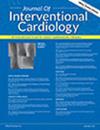Use of the Sheathless Eaucath Is an Effective Strategy to Overcome Resistant Severe Radial Spasm
Abstract
Objectives. We aimed to assess the effectiveness of the sheathless Eaucath guiding catheter (SEGC) in overcoming severe spasm. Background. Radial spasm is a frequent challenge in transradial access (TRA) and can be difficult to manage. Methods. We performed a prospective observational study of 1000 consecutive patients undergoing coronary angiography with or without percutaneous coronary intervention. Patients with primary transfemoral access (TFA) or primary use of a sheathless guide catheter were excluded. Patients who developed angiographically confirmed severe spasm were treated with further sedation and vasodilators. If the conventional catheter would still not advance, it was exchanged for a SEGC. The primary endpoint was the successful passage of the SEGC through the radial with successful engagement of the coronary artery in patients with resistant severe spasm. Results. Primary TFA access was used in 58 (5.8%) and primary radial access with a SEGC in 44 (4.4%) patients. Of the remaining 898 patients, 888 (98.9%) had a radial sheath successfully inserted. Of these, 49 (5.5%) developed severe radial spasm with inability to advance the catheter. Following treatment with additional sedation and vasodilators, the severe spasm resolved in 5 (10.2%) patients. Passage of a SEGC was attempted in the remaining 44 patients with resistant severe spasm. Passage of the SEGC and engagement of coronary arteries were successful in all cases. There were no complications related to use of the SEGC. Conclusions. Our findings suggest that use of the SEGC for resistant severe spasm is highly effective, safe, and may reduce the need for conversion to TFA.


 求助内容:
求助内容: 应助结果提醒方式:
应助结果提醒方式:


